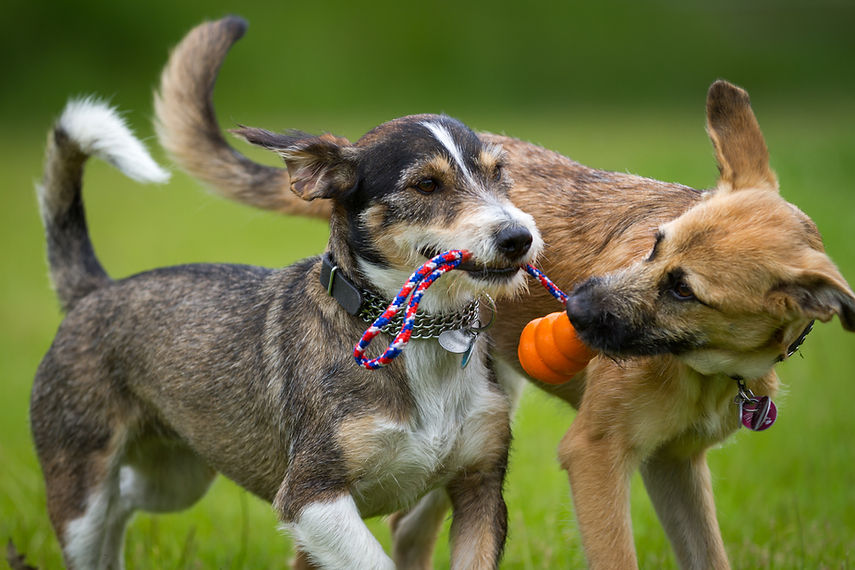
Playgroups
Using Toys and Food in the Groups
USING TOYS AND FOOD IN DOG PLAYGROUPS
Treats and toys can be used to interrupt problem play. You can use treats and toys to reinforce behaviors you’d like to see more of during dog playgroups. However, there is often worry that dog fights will result from food or toy guarding. While the risks & benefits should be weighed, we believe that the benefits of using food and toys during dog playgroups far outweigh the risks most of the time. You can minimize the risk of fights resulting from resource guarding using a few simple techniques.
TOYS
There are several scenarios in which toys can decrease problem behavior and/or increase desired behavior during dog playgroups:
-
Hard biting: Some dogs bite hard enough during play to bother playmates. If the dog will carry a toy in his mouth during play, the problem is often avoided.
-
Dog “pestering” another dog: Sometimes a dog focuses unwanted attention on a particular playmate. If the dog is interested in toys, introducing toys to the play yard will often divide the dog’s attention and make playgroup more enjoyable for all the dogs.
-
Dog doesn’t interact with other dogs: Some dogs strongly prefer playing with toys with other dogs, such as tug or keep-away. In some cases the dog won’t play at all until there is a toy present.
-
Dog is uncomfortable in playgroup: Some dogs may be nervous in a new situation, but if they enjoy playing with toys may relax and become more comfortable.
FOOD
The following are important uses of treats in dog playgroups:
-
Preventing crowding the play yard entrance: If dogs tend to crowd the entrance when new dogs enter the yard, handlers in the yard can call or prompt dogs away from the entrance & reward with treats.
-
Developing a positive interrupter (such as a recall word): Dogs learn that when you make certain noises, they will be rewarded if they come to you, away from play. This is helpful for interrupting any worrisome interactions without touching the dogs.
-
Interrupting tense interactions or play with decreasing or absent play signals (see What is Normal Play): If two dogs are interacting with stiff bodies, or playing but play signals are decreasing or lacking, prompting them away for treats or even showing them treats (at a safe distance from their faces) can interrupt the problematic interaction.
-
Returning to a playmate after a “no” response to a consent test: If a dog tries to go back to play that their playmate wasn’t consenting to, a handler can instead ask for and reward other behaviors (sit, touch, etc.) using treats.
-
Rewarding behaviors: Any behaviors you’d like to build during playgroup, including being called out of play, can be rewarded with treats.
MINIMIZING RISK OF RESOURCE GUARDING
The risk of dogs guarding toys or treats during playtime can be minimized using the following methods:
-
Keep moving. Avoid standing still for more than a few seconds at a time if dogs are nearby, so a “guardable space” isn’t created.
-
Keep treats in a pocket or a treat bag up around your shoulder if dogs are trying to grab treat bags that are at waist level.
-
Feed dogs with separate hands far apart from each other if delivering treats to two dogs at once.
-
Move away if more than two dogs approach for treats.
-
Avoid using toys if there is a dog who is known to start fights over toys (unless choosing to do behavior modification, especially with puppies).
-
Use larger toys, like long tug toys, that allow more space between the dogs if both holding the toy. This might reduce guarding but is not guaranteed to.
-
Provide multiple toys, enough for every dog to have one.
-
Use toys that are hard for dogs to hold in their mouths, like jolly eggs. Some dogs will still guard these toys however.
DOCUMENTATION PROCESS
-
Note on the dog's Play Profile Sheet if the dog played using toys, and what types of toys worked well.
-
Note any issues observed with food guarding when using treats.
